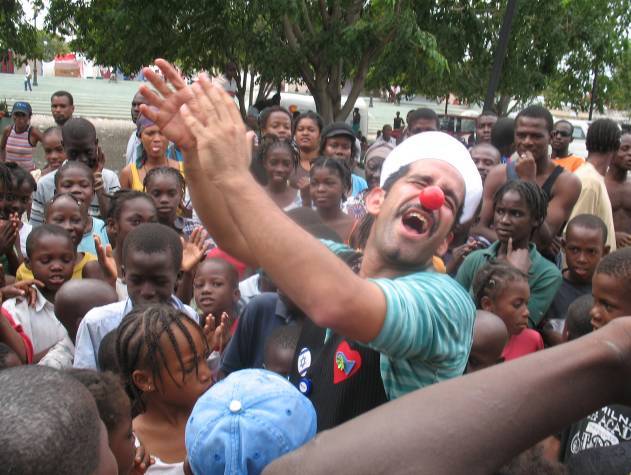
What could medical clowns do amidst the devastating suffering in the aftermath of Haiti’s earthquake? “It’s all about finding connections between people, being sensitive to them, and thus allowing them to open themselves emotionally,” explains Medical Clown Dudi Barashi, member of the Hadassah Medical Center’s global outreach team for the past six years.
Barashi has helped AIDS-stricken orphans in Ethiopia, survivors of the tsunami in Southeast Asia, and civilians under bombardment in Northern Israel but, he says, he has never seen anything that compares with the misery and destruction he witnessed in Haiti. As Barashi explains: “I went up to a child, perhaps two or three years old. His family was gone, his home was gone. But he was still a little boy. His attention was drawn by the man in the funny clothes. I smiled. He smiled. I made a funny face. He smiled more broadly. For a little while, at least, he left his fear and his pain.”
Strewn amid the rubble of what had been Haiti’s capital was a heap of splintered school desks and benches. Nearby lay a blackboard, still whole, with half a sentence chalked on to it. “That unfinished sentence symbolized it all for me,” says Barashi. “In my mind’s eye, I could see that Port au Prince teacher writing on the board, with the children watching as the earthquake struck and probably killed them all.”
Barashi was one of four Israeli clowns who arrived in Haiti on the Friday following the Tuesday earthquake. As delicately as Barashi and his colleagues work with sick youngsters in Hadassah Hospital, seeking their unspoken permission to come closer, that delicacy was magnified many times among the traumatized children they met in Haiti. “We took our cue from the youngsters,” he says.
There was, for example, a little girl whose crushed leg had been amputated just above the knee. Her dressing needed changing, but she was in pain and screaming: “Be careful of my leg!” Barashi went over and repeated her words, as best he could in the language in which she spoke them. “She stopped struggling and stared at me,” he said. “I said her words again. And then I chanted them and then began to sing them, mugging around. She giggled and joined in my ‘song,’ correcting my pronunciation as we sang–and the nurse changed her dressing.”
Barashi notes, too: “We medical clowns realized very quickly that our role wasn’t only to reach out to the battered people of Haiti, but also to our own emotionally and physically shattered team.” Soon after the clowns had arrived, Barashi was standing outside the field hospital, when one of the doctors he knew from Hadassah came out of surgery. Catching sight of him, the doctor smiled and asked: “What in heaven are you doing here?” Barashi answered, “I’m here to bring that smile to your face.”
The medical clowns joined the Israeli search-and-rescue team on visits to people living in temporary camps–people who’d lost everything and were simply sitting in the heat all day long. The clowns provided a diversion. To reach these shocked, bereaved people, with whom he had no common language, Barashi relied on instinct. “There was a little girl with long strands of twisted hair,” he relates, “so I ruffled it and called ‘Spaghetti!’ She laughed and some others grinned. I looked at more kids and likened their hair to other foods and pretty soon we had a whole kitchen going, with more and more children and some of the adults joining in.”
One time when the Israeli search-and-rescue team carried a giant water container into a camp like this, Barashi began singing the Hebrew song, “Moses Struck the Rock, and Water Gushed Forth.” The whole search-and-rescue team knew it and joined in. And with its repetitive Mayim, Mayim (Water, Water) at the end of each line, it wasn’t long before the Haitians were singing along.
“The Israeli flag was part of my clown costume,” explains Barashi. “Our personnel and our hospital were clearly identifiable as Israeli. The Haitians knew who we were and they were simply grateful that we’d crossed the world to help them.”
Information excerpted from an article by Wendy Elliman
